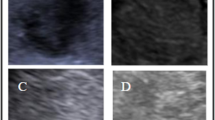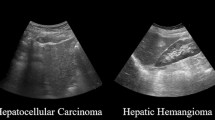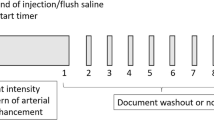Abstract
An ultrasound (US) examination is a common noninvasive technique widely applied for diagnosis of a variety of diseases. Based on the rapid development of US equipment, many US images have been accumulated and are now available and ready for the preparation of a database for the development of computer-aided US diagnosis with deep learning technology. On the contrary, because of the unique characteristics of the US image, there could be some issues that need to be resolved for the establishment of computer-aided diagnosis (CAD) system in this field. For example, compared to the other modalities, the quality of a US image is, currently, highly operator dependent; the conditions of examination should also directly affect the quality of US images. So far, these factors have hampered the application of deep learning-based technology in the field of US diagnosis. However, the development of CAD and US technologies will contribute to an increase in diagnostic quality, facilitate the development of remote medicine, and reduce the costs in the national health care through the early diagnosis of diseases. From this point of view, it may have a large enough potential to induce a paradigm shift in the field of US imaging and diagnosis of liver diseases.

Similar content being viewed by others
References
Kudo M. Breakthrough imaging in hepatocellular carcinoma. Liver Cancer 2016;5:47–54
Makino Y, Imai Y, Igura T, Kogita S, Sawai Y, Fukuda K et al. Feasibility of extracted-overlay fusion imaging for intraoperative treatment evaluation of radiofrequency ablation for hepatocellular carcinoma. Liver Cancer 2016;5:269–279
Kudo M. Defect reperfusion rmaging with sonazoid(R): a breakthrough in hepatocellular carcinoma. Liver Cancer 2016;5:1–7
Park HJ, Choi BI, Lee ES, Park SB, Lee JB. How to differentiate borderline hepatic nodules in hepatocarcinogenesis: emphasis on imaging diagnosis. Liver Cancer 2017;6:189–203
Mohammed HA, Yang JD, Giama NH, Choi J, Ali HM, Mara KC et al. Factors influencing surveillance for hepatocellular carcinoma in patients with liver cirrhosis. Liver Cancer 2017;6:126–136
Minhas F, Sabih D, Hussain M. Automated classification of liver disorders using ultrasound images. J Med Syst 2012;36:3163–3172
Esses SJ, Lu X, Zhao T, Shanbhogue K, Dane B, Bruno M et al. Automated image quality evaluation of T2-weighted liver MRI utilizing deep learning architecture. J Magn Reson Imaging 2018;47:723–728
Yasaka K, Akai H, Abe O, Kiryu S. Deep learning with convolutional neural network for differentiation of liver masses at dynamic contrast-enhanced CT: a preliminary study. Radiology 2018;286:887–896
Huang Q, Zhang F, Li X. Machine learning in ultrasound computer-aided diagnostic systems: a survey. Biomed Res Int 2018;2018:5137904
Gulshan V, Peng L, Coram M, Stumpe MC, Wu D, Narayanaswamy A et al. Development and validation of a deep learning algorithm for detection of diabetic retinopathy in retinal fundus photographs. JAMA 2016;316:2402–2410
Ehteshami B, Veta M, van Diest PJ, van Ginneken B, Karssemeijer N, Litjens G et al. Diagnostic assessment of deep learning algorithms for detection of lymph node metastases in women with breast cancer. JAMA 2017;318:2199–2210
Esteva A, Kuprel B, Novoa RA, Ko J, Swetter SM, Blau HM et al. Dermatologist-level classification of skin cancer with deep neural networks. Nature 2017;542:115–118
Kermany DS, Goldbaum M, Cai W, Valentim CCS, Liang H, Baxter SL, et al. Identifying medical diagnoses and treatable diseases by image-based deep learning. Cell 2018;172(1122–1131):e1129
Huang W, Li N, Lin Z, Huang GB, Zong W, Zhou J et al. Liver tumor detection and segmentation using kernel-based extreme learning machine. Conf Proc IEEE Eng Med Biol Soc 2013;2013:3662–3665
Mittal D, Kumar V, Saxena SC, Khandelwal N, Kalra N. Neural network based focal liver lesion diagnosis using ultrasound images. Comput Med Imaging Graph 2011;35:315–323
Nishida N, Kudo M. Alteration of epigenetic profile in human hepatocellular carcinoma and its clinical implications. Liver Cancer 2014;3:417–427
Virmani J, Kumar V, Kalra N, Khandelwal N. SVM-based characterization of liver ultrasound images using wavelet packet texture descriptors. J Digit Imaging 2013;26:530–543
Virmani J, Kumar V, Kalra N, Khandelwal N. Characterization of primary and secondary malignant liver lesions from B-mode ultrasound. J Digit Imaging 2013;26:1058–1070
Hwang YN, Lee JH, Kim GY, Jiang YY, Kim SM. Classification of focal liver lesions on ultrasound images by extracting hybrid textural features and using an artificial neural network. Biomed Mater Eng 2015;26(Suppl 1):S1599–S1611
Streba CT, Ionescu M, Gheonea DI, Sandulescu L, Ciurea T, Saftoiu A et al. Contrast-enhanced ultrasonography parameters in neural network diagnosis of liver tumors. World J Gastroenterol 2012;18:4427–4434
Gatos I, Tsantis S, Spiliopoulos S, Skouroliakou A, Theotokas I, Zoumpoulis P et al. A new automated quantification algorithm for the detection and evaluation of focal liver lesions with contrast-enhanced ultrasound. Med Phys 2015;42:3948–3959
Kondo S, Takagi K, Nishida M, Iwai T, Kudo Y, Ogawa K et al. Computer-aided diagnosis of focal liver lesions using contrast-enhanced ultrasonography with perflubutane microbubbles. IEEE Trans Med Imaging 2017;36:1427–1437
Guo LH, Wang D, Qian YY, Zheng X, Zhao CK, Li XL et al. A two-stage multi-view learning framework based computer-aided diagnosis of liver tumors with contrast enhanced ultrasound images. Clin Hemorheol Microcirc 2018;69:343–354
Subramanya MB, Kumar V, Mukherjee S, Saini M. A CAD system for B-mode fatty liver ultrasound images using texture features. J Med Eng Technol 2015;39:123–30
Mihailescu DM, Gui V, Toma CI, Popescu A, Sporea I. Computer aided diagnosis method for steatosis rating in ultrasound images using random forests. Med Ultrason 2013;15:184–190
Kim KB, Kim CW. Quantification of hepatorenal index for computer-aided fatty liver classification with self-organizing map and fuzzy stretching from ultrasonography. Biomed Res Int 2015;2015:535894
Acharya UR, Raghavendra U, Fujita H, Hagiwara Y, Koh JE, Hong TJ et al. Automated characterization of fatty liver disease and cirrhosis using curvelet transform and entropy features extracted from ultrasound images. Comput Biol Med 2016;79:250–258
Procopet B, Cristea VM, Robic MA, Grigorescu M, Agachi PS, Metivier S et al. Serum tests, liver stiffness and artificial neural networks for diagnosing cirrhosis and portal hypertension. Dig Liver Dis 2015;47:411–416
Gatos I, Tsantis S, Spiliopoulos S, Karnabatidis D, Theotokas I, Zoumpoulis P et al. A machine-learning algorithm toward color analysis for chronic liver disease classification, employing ultrasound shear wave elastography. Ultrasound Med Biol 2017;43:1797–1810
Zhang L, Li QY, Duan YY, Yan GZ, Yang YL, Yang RJ. Artificial neural network aided non-invasive grading evaluation of hepatic fibrosis by duplex ultrasonography. BMC Med Inform Decis Mak 2012;12:55
Biswas M, Kuppili V, Edla DR, Suri HS, Saba L, Marinhoe RT et al. Symtosis: a liver ultrasound tissue characterization and risk stratification in optimized deep learning paradigm. Comput Methods Programs Biomed 2018;155:165–177
Wang K, Lu X, Zhou H, Gao Y, Zheng J, Tong M, et al. Deep learning Radiomics of shear wave elastography significantly improved diagnostic performance for assessing liver fibrosis in chronic hepatitis B: a prospective multicentre study. Gut 2018. https://doi.org/10.1136/gutjnl-2018-316204.
Banzato T, Bonsembiante F, Aresu L, Gelain ME, Burti S, Zotti A. Use of transfer learning to detect diffuse degenerative hepatic diseases from ultrasound images in dogs: a methodological study. Vet J 2018;233:35–40
Zeng YZ, Zhao YQ, Liao M, Zou BJ, Wang XF, Wang W. Liver vessel segmentation based on extreme learning machine. Phys Med 2016;32:709–716
Nishida N, Kitano M, Sakurai T, Kudo M. Molecular mechanism and prediction of sorafenib chemoresistance in human hepatocellular carcinoma. Dig Dis 2015;33:771–779
Nishida N, Arizumi T, Hagiwara S, Ida H, Sakurai T, Kudo M. MicroRNAs for the prediction of early response to sorafenib treatment in human hepatocellular carcinoma. Liver Cancer 2017;6:113–125
Nishida N, Kudo M. Immune checkpoint blockade for the treatment of human hepatocellular carcinoma. Hepatol Res 2018;48:622–634
Tarek M, Hassan ME, El-Sayed S. Diagnosis of focal liver diseases based on deep learning technique for ultrasound images. Arab J Sci Eng 2017;42:3127–3140
Meng DZL, Cao G, Cao W, Zhang G, Hu B. Liver fibrosis classification based on trasnfer learning adn FCNet for ultrasound image. IEEE Access 2017;5:5804–5810
Liu X, Song JL, Wang SH, Zhao JW, Chen YQ. Learning to diagnose cirrhosis with liver capsule guided ultrasound image classification. Sensors 2017;17:E149(Basel).
Acknowledgements
This work was supported by Japan Agency for Medical Research and Development under the Grant number 18lk1010030h0001 (M. Kudo, T. Shiina, N. Nishida), and partially supported by Grant-in-Aid for Scientific Research (KAKENHI: 16K09382) from the Japanese Society for the Promotion of Science (N. Nishida) and a grant from the Smoking Research Foundation (N. Nishida).
Author information
Authors and Affiliations
Corresponding author
Ethics declarations
Conflict of interest
The authors have no conflicts of interest to disclose.
Ethical approval
This is not a research paper involving human participants and/or animals; informed consent is not required.
Informed consent
Informed consent is not required.
Additional information
Publisher's Note
Springer Nature remains neutral with regard to jurisdictional claims in published maps and institutional affiliations.
Rights and permissions
About this article
Cite this article
Nishida, N., Yamakawa, M., Shiina, T. et al. Current status and perspectives for computer-aided ultrasonic diagnosis of liver lesions using deep learning technology. Hepatol Int 13, 416–421 (2019). https://doi.org/10.1007/s12072-019-09937-4
Received:
Accepted:
Published:
Issue Date:
DOI: https://doi.org/10.1007/s12072-019-09937-4




